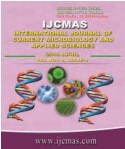


 National Academy of Agricultural Sciences (NAAS)
National Academy of Agricultural Sciences (NAAS)

|
PRINT ISSN : 2319-7692
Online ISSN : 2319-7706 Issues : 12 per year Publisher : Excellent Publishers Email : editorijcmas@gmail.com / submit@ijcmas.com Editor-in-chief: Dr.M.Prakash Index Copernicus ICV 2018: 95.39 NAAS RATING 2020: 5.38 |
An interaction between different dietary levels of T-2 toxin and Salmonella gallinarum infection was studied in broiler chicken and the role of dietary supplementation of arginine (ARG) [22 g/kg] and vitamin E (VE) [80 mg/kg] in minimizing salmonella persistence in the system was evaluated. Ninety eight day-old commercial broiler chicks were randomly allotted in equal numbers to the following groups. The Group I had two subgroups- Positive Control (PC) and Negative Control (NC) and dietary T-2 toxin level was 0.0 in both the subgroups. Groups II, III, and IV received 0.25ppm, 0.50ppm, 1ppm of dietary T-2 toxin. Arginine (22 g/kg) and vitamin E (80 mg/kg) were supplemented to Groups V and VI which respectively had 0.0 and 1 ppm of dietary T-2 toxin. The test diets were fed for 0-35 days. Each bird in different groups excepting those of NC was challenged orally with 107 CFU of S. gallinarum on day 28. Feed efficiency was significantly (P≤0.05) low after the salmonella challenge in all the toxin fed groups compared to PC. FCR in ARG and VE supplemented birds was similar to that of NC despite being challenged with salmonella. Birds fed with 0.5ppm of T-2 toxin recorded significantly (P≤0.05) higher viable counts of salmonella in liver on day 7 PI whereas birds fed 1ppm of toxin showed higher viable counts on days 3 and 7 PI compared to positive control birds. However, ARG and VE supplemented birds recorded significantly (P≤0.05) lower viable counts on day 7 PI. The study revealed a significant interaction between T-2 toxin and S. gallinarum and dietary supplementation of ARG and VE was effective in clearing the salmonella organisms from the system.
 |
 |
 |
 |
 |